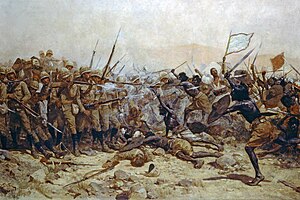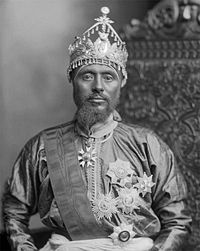Sougoulie: Difference between revisions
m (since looks like we'll be using colonial names) |
|||
| Line 48: | Line 48: | ||
==Origins== | ==Origins== | ||
{{main|Toubacterie}} | {{main|Toubacterie}} | ||
During the [[Toubacterie#Woundie|Woundic period]] the [[Euclea|Euclean]] colonisation of [[Bahia]] cemented itseld not only as a form of economic hegemony but of direct political control over the subcontinent. | [[File:Felice Beato (British, born Italy - Two Sepoys of the 31st Native Infantry, Who Were Hanged at Lucknow, 1857 - Google Art Project.jpg|200px|thumb|Two Fetishists hung for taking part in a sacrifice, [[Mabifia]], 1865]] | ||
During the [[Toubacterie#Woundie|Woundic period]] the [[Euclea|Euclean]] colonisation of [[Bahia]] cemented itseld not only as a form of economic hegemony but of direct political control over the subcontinent. One of the key grievances was related to the number of missionaries who were flocking to Bahia in the hopes of spreading [[Sotirianity]] to the natives. These missionaries received protection from the Euclean powers, permitting them to evangelise freely and giving them a free pass to any actions related to the spreading of the faith. This blank cheque led to increasingly brazen attacks on traditional Bahian religion, especially [[Bahian fetishism|fetishism]] which was targetted due to its {{wp|pagan}} nature. Idols were destroyed and priests unmasked during religious ceremonies, which led to a large amount of anger. The fetishist population in Bahia was decimated by these missionaries, leading the remaining believers to resent the colonists and their religious influences. In [[Irfan|Irfanic]] majority areas too, there was widespread persecution against believers. As Bahia was a highly religious area, these encroachments on the strong religious roots of these communities was a major source of conflict and helped to motivate large numbers to join the Sougoulie. There had been several smaller disturbances based upon religion across Bahia before the Sougoulie erupted, but they were swiftly suppressed by the colonial authorities. | |||
Another major cause of anger towards [[Toubacterie]] was the economic oppression of the subcontinent's native majority at the hands of the small white minority. Commercial interests had played an enormous part in the [[Toubacterie#Fatougole|Fatougole]], with industrialists such as [[Jean Dumont]] personally funding colonial expeditions into Bahia to gain access to its natural riches. Resources such as the famous {{wp|gold mines}} of the [[Kambou valley]] and [[Gonda river]] were quickly seized by colonists, with the natives who had owned such riches being pushed aside and driven from their lands. In [[Rwizikuru|Riziland]], large tracts of arable land were requisitioned and taken by the [[Murungu]], white settlers aiming to establish themselves in the area. These land requisitions most often came at the expense of the former [[Hourege|Houregic elite]], who lost their influence over society. The Euclean colonisers had abolished the {{wp|caste system}} as soon as they came into power, freeing the slaves and destroying the legal authority of the tribal elders and clergy. The freeing of slaves alone destroyed roughly 80% of the economic power of these former elites who became a shadow of themselves. Despite this legal abolition of the caste system, it was highly ingrained into the Bahian mindset and many, especially those of the upper classes, continued to follow it behind closed doors. This meant that the [[Act of Quartering Reform]], whilst from the Euclean perspective being inoffensive and common sense, was highly provocative to the predominantly upper-caste native soldiers who were drawn primarily from the warrior caste and expected the privileges that they had held under Hourege. | |||
==Outbreak== | ==Outbreak== | ||
Revision as of 11:22, 28 December 2019
| Sougoulie | |||||||
|---|---|---|---|---|---|---|---|
| Part of Toubacterie | |||||||
 Ndjarendie soldiers under Saïkou Ahmed Bamba clash with Gaullican troops during the Battle of Ourafade | |||||||
| |||||||
| Belligerents | |||||||
|
Template:Country data Estmere |
Soubaka Dominion of Heaven Kambou Karanate Ichïamba | ||||||
| Commanders and leaders | |||||||
|
Crumpet dude Sausage dude |
Saïkou Ahmed Bamba Fatima Maal Jean-Paul Rugima | ||||||
| Strength | |||||||
|
Template:Country data Estmere 13,000 | 200,000 | ||||||
| Casualties and losses | |||||||
| 2,000 | 100,000 | ||||||
The Sougoulie was a major unsuccessful revolt against Euclean colonisation in Bahia that took place in 1883 and 1884. It began in Meyrout, which was used by the Gaullicans as a garrison point for their Tirailleurs Bahiens, on the 23rd of May 1883 after the local garrison mutinied in revolt against the Act of Bahian Quartering Reform. As news of the revolt spread, other localised revolts broke out across the subcontinent. These revolts aimed to bring back the return of local rule and often resulted in the reformation of previously existing Houregic states, posing a threat to Euclean control over the region. The revolts were eventually defeated in 1884, following the defeat of the Soubaka Dominion of Heaven under Saïkou Ahmed Bamba. The name of the event is contested by historians as while the Bahian name of Sougoulie is widely accepted in Bahia, Euclean scholars disagree on the magnitude of the revolts. As such, the terms Bahian Mutiny, Tirailleur Mutiny and Bahian Rebellion of 1883 are also used. The term Sougoulie somes from a Ndjarendie root word for a meal taken before sunrise, which characterises the revolts as a first taste of freedom before the Kaoule.
While the catalyst cause of the Sougoulie was quartering reform within the Gaullican army, the revolts soon took a broader aspect of resistance against the cultural and religious repression of Bahian society by their Euclean colonisers as well as the economic expropriation of lands and resources by Euclean corporations. While many Bahians, particularly amongst the marginalised Irfanic and Fetishist pupulations, joined the revolts, many Sotirian Bahians instead fought alongside the Eucleans. The Sougoulie was a period of intense violence, particularly against the civilian population. Both sides were reported to have perpetrated massacres, with the Gaullican sack of Kambou being one of the most well-known examples.
In most cases, the revolts constituted a reactionary effort to reinstitute Hourege and the status quo before Toubacterie. There was not any major effort to cooperate between the different rebel groups, who often fought amongst themselves as well as fighting the Euclean forces. This division of resistance essentially doomed the revolts to failure, as they were unable to cross ethnic or religious lines against a common enemy and could therefore be defeated one by one. This failure was a key inspiration in the development of Pan-Bahianism, as the importance of a united struggle against colonialism was demonstrated.
Origins

During the Woundic period the Euclean colonisation of Bahia cemented itseld not only as a form of economic hegemony but of direct political control over the subcontinent. One of the key grievances was related to the number of missionaries who were flocking to Bahia in the hopes of spreading Sotirianity to the natives. These missionaries received protection from the Euclean powers, permitting them to evangelise freely and giving them a free pass to any actions related to the spreading of the faith. This blank cheque led to increasingly brazen attacks on traditional Bahian religion, especially fetishism which was targetted due to its pagan nature. Idols were destroyed and priests unmasked during religious ceremonies, which led to a large amount of anger. The fetishist population in Bahia was decimated by these missionaries, leading the remaining believers to resent the colonists and their religious influences. In Irfanic majority areas too, there was widespread persecution against believers. As Bahia was a highly religious area, these encroachments on the strong religious roots of these communities was a major source of conflict and helped to motivate large numbers to join the Sougoulie. There had been several smaller disturbances based upon religion across Bahia before the Sougoulie erupted, but they were swiftly suppressed by the colonial authorities.
Another major cause of anger towards Toubacterie was the economic oppression of the subcontinent's native majority at the hands of the small white minority. Commercial interests had played an enormous part in the Fatougole, with industrialists such as Jean Dumont personally funding colonial expeditions into Bahia to gain access to its natural riches. Resources such as the famous gold mines of the Kambou valley and Gonda river were quickly seized by colonists, with the natives who had owned such riches being pushed aside and driven from their lands. In Riziland, large tracts of arable land were requisitioned and taken by the Murungu, white settlers aiming to establish themselves in the area. These land requisitions most often came at the expense of the former Houregic elite, who lost their influence over society. The Euclean colonisers had abolished the caste system as soon as they came into power, freeing the slaves and destroying the legal authority of the tribal elders and clergy. The freeing of slaves alone destroyed roughly 80% of the economic power of these former elites who became a shadow of themselves. Despite this legal abolition of the caste system, it was highly ingrained into the Bahian mindset and many, especially those of the upper classes, continued to follow it behind closed doors. This meant that the Act of Quartering Reform, whilst from the Euclean perspective being inoffensive and common sense, was highly provocative to the predominantly upper-caste native soldiers who were drawn primarily from the warrior caste and expected the privileges that they had held under Hourege.
Outbreak
Bahian divisions
The Revolts
Soubaka
Kambou
Ichïamba
Riziland
As Estmerish forces continued advancing into the Plateau, the native villages in the Plateau realised that continuing the village system would inevitably mean that each village could be annexed into the Estmerish colony of Riziland. Thus, in 1881, the chieftains of the villages met in Munzwa to establish a neo-veRwizi Empire, known as the Verizi Empire, with the chieftain of Munzwa, Tamutswa being named Mambo of the Verizi Empire.
When word of the Sougoulie spread to the Plateau, Tamutswa called for all veRwizi chieftains to join the rebellion to "expel the Murungu" from Rwizikuru, and restore the veRwizi Empire under Mambo Tamutswa.
(TBC)
Baséland
While a major revolt that could be categorised as part of the Sougoulie never occurred in the colony of Baséland (now Garambura), many underground resistance groups secretly pledged their allegiance to those fighting in the Sougoulie, particularly the resurgent Verizi Empire, and arranged for their undocumented transportation into Sainte-Germaine's outer bounds, where population documentation was rare. As the population in Baséland was so heavily concentrated around the coastal city, owing mainly to the Adunis to Mambiza Railway, a revolt at the level of the Sougoulie was unfeasible, with dissidents of the Eucleans realising the fact quickly.
While some chose to travel to Mabifia and Riziland to fight alongside the Sougoulie rebels, most stayed in the colony, fearing for their lives and the lives of their families. Some still chose to show their solidarity by assisting the rebels in a logistical sense, with supplies often being stolen at the port of Sainte-Germaine and sent along a network of rebel-organised transporters until they reached rebel hotspots. Perhaps the most well-known and largest sign of resistance from Garambura was Yebase ship commander Alphonse Amsalu's sinking of the NSM Insulaire in November 1883, a Gaullican supply ship carrying military supplies to fighting soldiers in Mabifia. Amsalu fired on the unexpecting ship, sinking the ship itself, its 105 crew and all of its supplies, he was sentenced to death for 105 counts of murder and treason in Sainte-Germaine in 1884, but is a well-known folk story in Garambura detailing heroism and resistance against opression.
